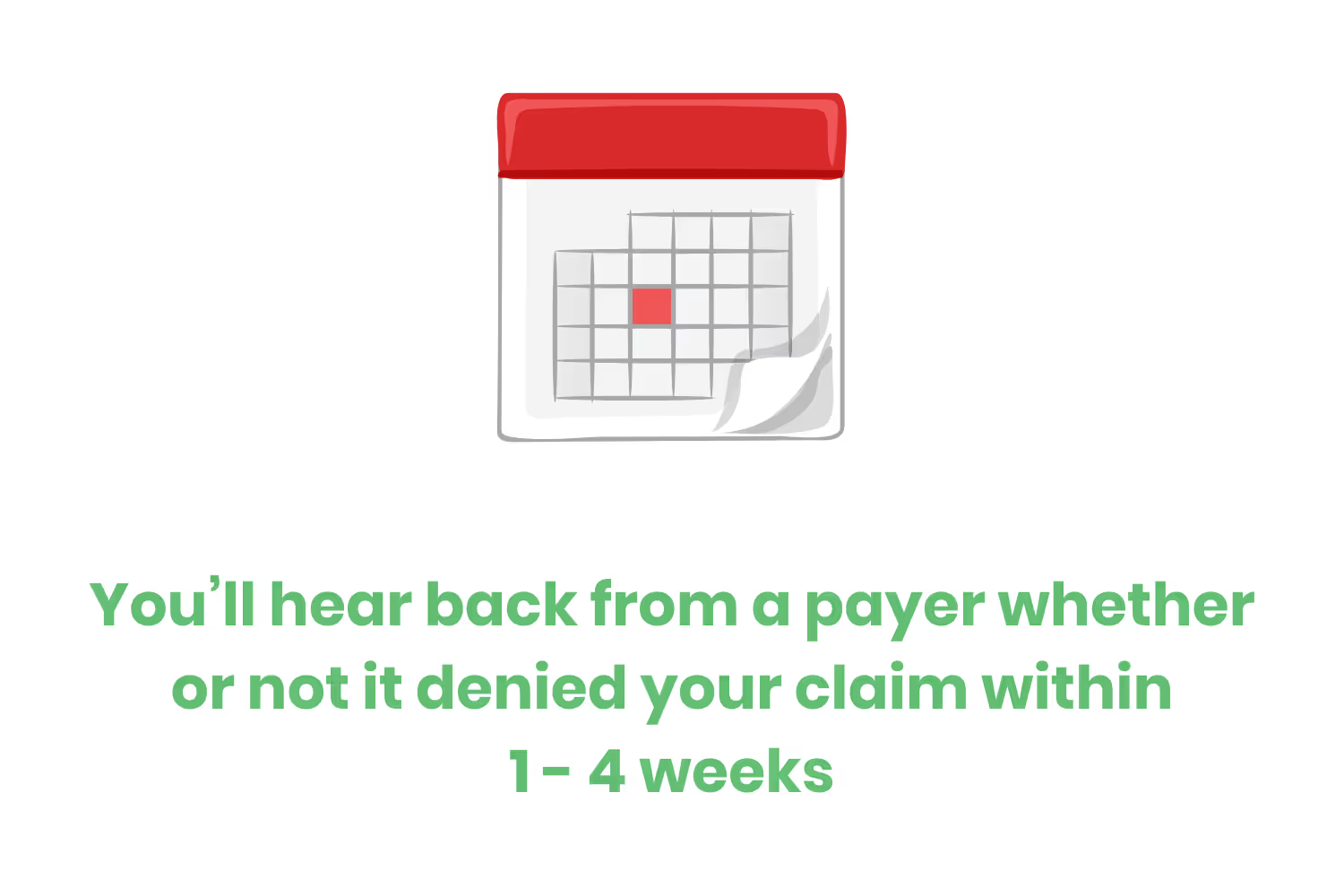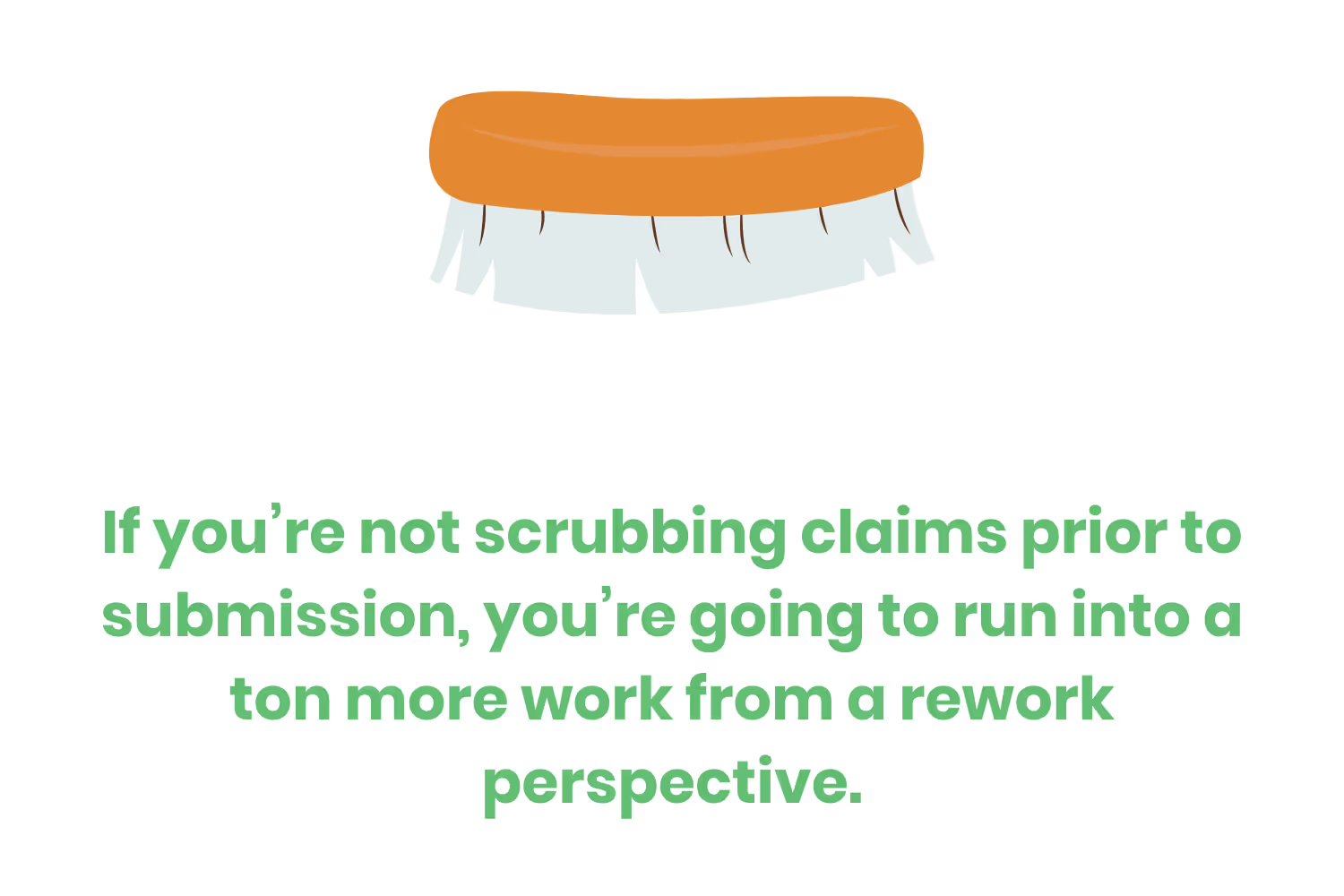Uh oh! The Effects of Not Having a Claim Scrubbed Prior to Submission
Let’s look at the question we’re all wondering, “What are the effects of not having a claim scrubbed prior to submission?”

Ask any medical biller what their arch-enemy is and they’ll identify one of the two main types of codes that they work with.
Of course, what I’m referring to are ICD codes and CPT codes…but if you’re working within the industry, you already knew that.
Although both types of those codes are an essential part of the medical billing process, they lead to a lot of headaches for billers and the organizations they represent.
Since both types of codes deal directly with the patient, they’re considered the front-end of the revenue cycle. Unfortunately, that also means both of those types of codes fall under the category that accounts for a lot of denials for healthcare organizations.
Front-end revenue cycle processes account for half of all claim denials on average.
If you’re not heavily involved in the medical billing world, you’re not feeling very optimistic about these two types of codes. I mean, I haven’t even defined them yet and I’ve thrown in a massively negative statistic about them.

International Classification of Disease (ICD) codes help define the problem that happened to a patient. Meanwhile, Current Procedural Terminology (CPT) identifies the treatment administered.
For example, if you went to the doctor because a roller skater ran into you while you were on your morning walk you would receive ICD-10 code V00.01. You came out from the collision unscathed but decided to go to your physician for safe measures. While you were there, the doctor gave you a physical, or CPT Z00.00.
Make sense?
Anyway, the reason why both of these types of codes cause so many denials for healthcare organizations is most likely attributed to the fact that there are so many of them. There are over 70,000 ICD-10 codes for clinical modifications (CM) alone. Adding another 10,000 CPT codes on top of all of that and you see why they cause so many headaches.
So, what can medical billers do to cut down on front-end claim denials? The answer is simple, claim scrubbing. Although that sounds like a nice and easy process, it’s not. Claim scrubbing is tedious, especially when done manually.
However, most organizations shouldn’t or simply can’t afford to write off all of their denials.
For the sake of this blog post, let’s say that you didn’t bother with assigning your front-end revenue cycle team claim scrubbing responsibilities. Or, your clearinghouse doesn’t do this job for you. In that case, let’s look at the question we’re all wondering, “What are the effects of not having a claim scrubbed prior to submission?”
Truckloads of Claim Rejections
I alluded to this section throughout the entirety of the introduction, but it’s so important that it needs to stand on its own.
You see, if you don’t scrub your claims prior to submission, you’re going to end up with a lot more claim rejections on your hands.
During the introduction, I alluded to the fact that front-end denials happen because of claims that aren’t scrubbed. Although that’s a correct statement, your clearinghouse should have your back before you submit to a payer and receive a denial.
If you don’t “feel the love” in that sense from your clearinghouse, you should consider switching to a different one altogether.
Anyway, the point I’m trying to make is that your clearinghouse should run your claims through an automated scrubbing process. If the clearinghouse finds errors in what you submit, it should reject it on its own level.

Think of your claims as a dirty car, your clearinghouse as a carwash and reimbursement as your destination. By the end of the carwash or submission, your car should be ready to get you to your destination. In this metaphor, though, your car is filthy and needs another run-through or resubmission after the first one before you hit the road.
That’s the process I’m referring to in a nutshell.
To keep the car metaphor going, clearinghouse rejected claims are like a check engine light. You could ignore it, but then you'd likely end up stranded on your way to the destination. On top of that, you have to spend a lot of time and money trying to fix something you could have caught earlier.
Now, receiving clearinghouse level claim rejections isn't the end of the world, they're better than payer level rejections.
To put it into perspective, it takes 1 - 3 days for the payer to reject a claim, that’s time most healthcare organizations don’t have readily available.
Payment Delays
The more rejections you receive on your claims, the longer it takes for your organization to receive payment.
Let’s say you waited until the end of the day to submit everything to each of your client’s payers. It was a long day of nothing but physicals and you have a family event to get to that you’re already late for. Thus, you glaze over each claim, hit submit and then go on your merry way.

3 days later you’re bombarded with payer rejections for each claim you submitted that day because you were one digit off in the CPT code for all of them.
This is a good place to mention that one day’s worth of claims is a lot, but it’s not unmanageable. What IS unmanageable is getting a ton of payer rejections every day because you have a hard time producing a clean claim.
See how things start cascading?
If you’re dealing with a new tidal wave of rejections every day, you won’t be able to stay on top of it. Side effects include payment delays.
You could, of course, hire an army of medical billers. But, that comes at a premium.
Loss in Revenue
Maybe your mentality is that you’ll submit what you can and whatever gets rejected by players will go into a never-ending to-do list of claims that require reconfiguration. Although that sounds reasonable, it’s not attainable.
You might already know this but insurance payers place timely filing limits on their claims. In other words, if you can’t submit or resubmit a claim to a payer within its allotted time frame, it’s going to get denied.
Ironically, you’ll hear back from a payer whether or not it denied your claim within 1 - 4 weeks.

So, if you’re keeping a pile of your rejections laying around you might as well consider them denials at this point.
Unfortunately, the industry trend in collecting from denials isn’t in your favor either. Healthcare organizations are writing off 90% more claim denials now than they did 6 years ago.
Like I mentioned in the previous section, getting a lot of payer rejections leads to delays in payment because of how tedious it is to clean them. Meanwhile, not fixing those rejected claims fast enough leads to denials.
Unless you happen to have access to a denial management solution or some well-written appeal letters, you’ll likely have to write your denials off. To tie it all together, writing off denials means a loss to your bottom line.
Spike in Employee Burnout
You’ve probably heard this at some point from mainstream media outlets recently but the healthcare industry is drowning in work.
The rates of burnout are so bad right now that many healthcare professionals have decided to move away from the entire industry.
Of course, there are many reasons why burnout rates within this industry are so high. A lot of it has to do with the physician shortage in the US.

The point I’m trying to make is two-pronged. First, it’s that if most healthcare organizations face a staffing crisis, odds are yours is too. Second, it’s that the shortage of medical professionals is causing burnout rates to skyrocket because facilities don’t have enough bandwidth.
So, if you’re not scrubbing claims prior to submission, you’re going to run into a ton more work from a rework perspective. On top of that, you’re going to shrink your bottom line. The cherry on top is that your team, which is already overworked based on industry trends, will have more daily responsibilities to handle.
Frustrated Patients
With how involved it is to deal with insurance payers on the revenue cycle side of healthcare, it’s easy to forget the purpose of medical facilities in the first place.
Caring for patients is the reason why most professionals enter the industry in the first place.
Unfortunately, not scrubbing your claims could also affect the patients that seek services from your facility.

Think about it. If your team is so bogged down with trying to stay on top of your rejected claims to avoid denials…they won’t have time for your patients.
In those inevitable patient interactions, they’re going to be so focused on the mountain of work they have to do that the experience won’t be up to par.
You likely have everything from greeting patients to signing them out planned to ensure that your patient experience is exceptional. That can’t happen in the alternate reality where your organization isn’t scrubbing claims.
Conclusion
If you have a clearinghouse, it should “have your back” in the sense that it scrubs and rejects claims before submission to payers.
Yes, technically it’s coming from your clearinghouse it’s still a rejection that you’ll have to rework. However, clearinghouse rejections exist as a protective step in the process and they happen instantaneously.
Instead of having to wait several days for the payer to reject your claim, you can clean it as soon as you receive the instant notification from your clearinghouse.
It does still require effort, but it’s a much better and streamlined alternative than writing losses every year.
However, the best option that I have yet to list is to have a practice management (PM) system that scrubs your claims for you before any type of submission.
Emphasize your product's unique features or benefits to differentiate it from competitors
In nec dictum adipiscing pharetra enim etiam scelerisque dolor purus ipsum egestas cursus vulputate arcu egestas ut eu sed mollis consectetur mattis pharetra curabitur et maecenas in mattis fames consectetur ipsum quis risus mauris aliquam ornare nisl purus at ipsum nulla accumsan consectetur vestibulum suspendisse aliquam condimentum scelerisque lacinia pellentesque vestibulum condimentum turpis ligula pharetra dictum sapien facilisis sapien at sagittis et cursus congue.
- Pharetra curabitur et maecenas in mattis fames consectetur ipsum quis risus.
- Justo urna nisi auctor consequat consectetur dolor lectus blandit.
- Eget egestas volutpat lacinia vestibulum vitae mattis hendrerit.
- Ornare elit odio tellus orci bibendum dictum id sem congue enim amet diam.
Incorporate statistics or specific numbers to highlight the effectiveness or popularity of your offering
Convallis pellentesque ullamcorper sapien sed tristique fermentum proin amet quam tincidunt feugiat vitae neque quisque odio ut pellentesque ac mauris eget lectus. Pretium arcu turpis lacus sapien sit at eu sapien duis magna nunc nibh nam non ut nibh ultrices ultrices elementum egestas enim nisl sed cursus pellentesque sit dignissim enim euismod sit et convallis sed pelis viverra quam at nisl sit pharetra enim nisl nec vestibulum posuere in volutpat sed blandit neque risus.

Use time-sensitive language to encourage immediate action, such as "Limited Time Offer
Feugiat vitae neque quisque odio ut pellentesque ac mauris eget lectus. Pretium arcu turpis lacus sapien sit at eu sapien duis magna nunc nibh nam non ut nibh ultrices ultrices elementum egestas enim nisl sed cursus pellentesque sit dignissim enim euismod sit et convallis sed pelis viverra quam at nisl sit pharetra enim nisl nec vestibulum posuere in volutpat sed blandit neque risus.
- Pharetra curabitur et maecenas in mattis fames consectetur ipsum quis risus.
- Justo urna nisi auctor consequat consectetur dolor lectus blandit.
- Eget egestas volutpat lacinia vestibulum vitae mattis hendrerit.
- Ornare elit odio tellus orci bibendum dictum id sem congue enim amet diam.
Address customer pain points directly by showing how your product solves their problems
Feugiat vitae neque quisque odio ut pellentesque ac mauris eget lectus. Pretium arcu turpis lacus sapien sit at eu sapien duis magna nunc nibh nam non ut nibh ultrices ultrices elementum egestas enim nisl sed cursus pellentesque sit dignissim enim euismod sit et convallis sed pelis viverra quam at nisl sit pharetra enim nisl nec vestibulum posuere in volutpat sed blandit neque risus.
Vel etiam vel amet aenean eget in habitasse nunc duis tellus sem turpis risus aliquam ac volutpat tellus eu faucibus ullamcorper.
Tailor titles to your ideal customer segment using phrases like "Designed for Busy Professionals
Sed pretium id nibh id sit felis vitae volutpat volutpat adipiscing at sodales neque lectus mi phasellus commodo at elit suspendisse ornare faucibus lectus purus viverra in nec aliquet commodo et sed sed nisi tempor mi pellentesque arcu viverra pretium duis enim vulputate dignissim etiam ultrices vitae neque urna proin nibh diam turpis augue lacus.




